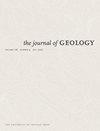拉达克西部印度河缝合带Sapi-Shergol蛇绿岩混杂岩的岩石学和地球化学:对岩石成因和构造环境的制约
IF 1.3
4区 地球科学
Q2 GEOLOGY
引用次数: 12
摘要
本文报告了在拉达克西部印度河缝合带的Sapi-Shergol蛇绿混杂岩中侵位的俯冲相关拉斑玄武岩、正常大洋中脊玄武岩(N-MORB)型镁铁质侵入岩的存在。Shergol镁铁质侵入岩显示Fe富集,成分为玄武岩至玄武岩安山岩。根据它们的矿物学和结构,这些镁铁质岩石可以被确定为经过绿片岩级变质作用的细到中粒辉长岩。这些岩石具有N-MORB型地球化学特征,表现出几乎平坦到贫化的轻稀土元素模式((La/Sm)N=0.66–1.05)。岩石成因建模表明,在尖晶石橄榄岩稳定性范围内,贫化MORB型地幔源的部分熔融小于20%。Nb、Zr和Ti等高场强元素在多元素模式中的轻微负异常反映了俯冲带岩浆作用的影响。低钛斜辉石(En38–50Fe11–25Wo31–43;顽火辉石-铁硅岩-硅灰石)、富钙斜长石(An2–36;安山岩)和共气化角闪石的存在也反映了它们与俯冲相关的贫化地幔起源。Shergol橄榄岩中Shergol辉长岩侵入体显示的MORB–岛弧拉斑玄武岩特征反映了它们在与新特提斯洋内早白垩世洋内俯冲有关的地幔楔中的生成。它们类似于来自拉达克南部的Spongtang蛇绿岩-地幔橄榄岩中侵入的Spongtong蛇绿岩辉长岩、来自西藏南部的蛇绿混杂辉长岩和来自巴基斯坦的Muslim Bagh蛇绿辉长岩。基于这项研究,我们提供了一个地球动力学模型,表明Sapi-Shergol蛇绿岩片被镁铁质侵入岩侵入,镁铁质侵入岩石代表了白垩纪Dras弧杂岩的海洋内底层遗迹。本文章由计算机程序翻译,如有差异,请以英文原文为准。
Petrology and Geochemistry of Mafic Intrusive Rocks from the Sapi-Shergol Ophiolitic Mélange, Indus Suture Zone, Western Ladakh: Constraints on Petrogenesis and Tectonic Setting
This article reports the existence of subduction-related tholeiitic, normal mid-ocean ridge basalt (N-MORB)-type mafic intrusives emplaced within the Sapi-Shergol ophiolitic mélange of the Indus Suture Zone, western Ladakh. The Shergol mafic intrusives show Fe enrichment with basalt to basaltic-andesite composition. Based on their mineralogy and textures, these mafic rocks can be identified as fine- to medium-grained gabbros that have undergone greenschist-grade metamorphism. These rocks have N-MORB-type geochemical characteristics, exhibiting nearly flat to depleted light rare earth element patterns ((La/Sm)N=0.66–1.05). Petrogenetic modeling suggests <20% partial melting of a depleted MORB-type mantle source, within the spinel peridotite stability. The presence of slightly negative anomalies of high field strength elements like Nb, Zr, and Ti in multielement patterns reflect the influence of subduction zone magmatism. The presence of low-Ti clinopyroxene (En38–50Fe11–25Wo31–43; enstatite-ferrosilite-wollastonite), Ca-rich plagioclase (An2–36; andesine), and pargasitic amphibole also reflects their subduction-related depleted-mantle origin. The MORB–island arc tholeiite signature displayed by the Shergol gabbros intrusive in Shergol peridotites reflect their generation in a mantle wedge associated with the Early Cretaceous intraoceanic subduction within the Neo-Tethys Ocean. They are similar to Spongtang ophiolite gabbros intrusive in the Spongtang ophiolite mantle peridotites from south Ladakh, ophiolitic mélange gabbros from southern Tibet, and Muslim Bagh ophiolite gabbros from Pakistan. Based on this study, we offer a geodynamic model suggesting that the Sapi-Shergol ophiolitic slice was intruded by mafic intrusive rocks that represent the relict of the intraoceanic substratum of the Cretaceous Dras arc complex.
求助全文
通过发布文献求助,成功后即可免费获取论文全文。
去求助
来源期刊

Journal of Geology
地学-地质学
CiteScore
3.50
自引率
5.60%
发文量
0
审稿时长
3 months
期刊介绍:
One of the oldest journals in geology, The Journal of Geology has since 1893 promoted the systematic philosophical and fundamental study of geology.
The Journal publishes original research across a broad range of subfields in geology, including geophysics, geochemistry, sedimentology, geomorphology, petrology, plate tectonics, volcanology, structural geology, mineralogy, and planetary sciences. Many of its articles have wide appeal for geologists, present research of topical relevance, and offer new geological insights through the application of innovative approaches and methods.
 求助内容:
求助内容: 应助结果提醒方式:
应助结果提醒方式:


